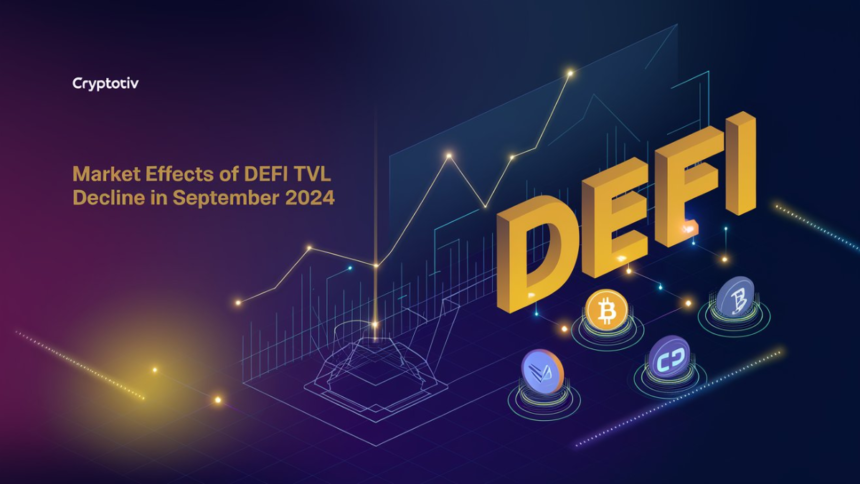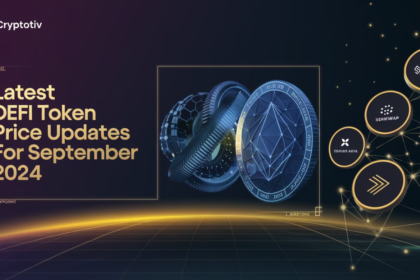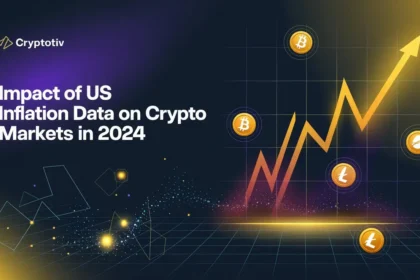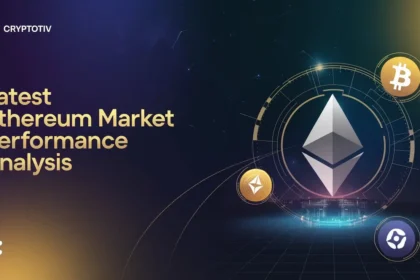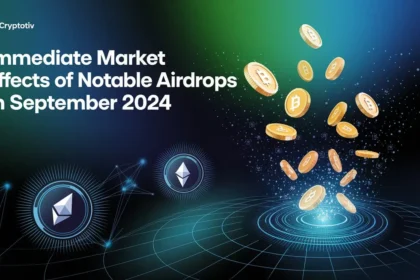The decline in DeFi TVL (Total Value Locked) has been a focal point in the cryptocurrency market throughout 2024, impacting market dynamics and investor sentiment. This downward trend in TVL has sparked discussions on its implications for decentralized finance, especially as it influences liquidity, platform performance, and overall market efficiency. Despite certain ecosystems like Sui and Solana experiencing growth, the broader DeFi market is grappling with a reduction in asset values. Understanding the market impact of TVL changes is crucial for navigating the current DeFi landscape, particularly in light of challenges like market volatility, regulatory pressures, and fluctuating investor confidence. The DeFi market reaction to TVL reduction highlights key trends and opportunities arising in September 2024.
Overview of DeFi TVL Decline in 2024
The year 2024 has been marked by a notable decline in the Total Value Locked (TVL) across various DeFi platforms. Despite some growth in certain ecosystems, such as Sui and Solana, the overall DeFi market has seen a downturn in asset values. This decline in TVL, a key indicator of the health and adoption of DeFi platforms, has raised concerns about market dynamics, liquidity, and investor confidence. While some platforms have continued to experience growth, like Sui, which broke the $500 million TVL barrier in early 2024, most DeFi assets have faced significant devaluation.
Key Drivers of DeFi TVL Decline
Several factors have contributed to the declining DeFi TVL in 2024:
- Market Volatility: Persistent volatility in the cryptocurrency market has led to fluctuations in DeFi asset values. This uncertainty has caused many investors to withdraw funds from DeFi protocols, leading to a drop in TVL.
- Regulatory Concerns: Increased regulatory scrutiny around DeFi platforms has also played a crucial role in the decline. Heightened regulations, especially regarding compliance and anti-money laundering (AML) policies, have prompted caution among investors, reducing the inflow of assets into DeFi protocols.
- Reduced Investor Confidence: Due to market instability and regulatory actions, investor sentiment toward DeFi has weakened. The significant losses in value of major DeFi assets have contributed to a lack of confidence, prompting investors to reassess their involvement in the DeFi space.
Comparative Analysis of TVL Decline Across Major DeFi Platforms
A comparative look at different DeFi platforms reveals a mixed picture.
| DeFi Platform | TVL in Early 2024 | TVL in September 2024 | Percentage Change |
|---|---|---|---|
| Sui | $250M | $500M | +100% |
| Solana | $1.5B | $2B | +33% |
| Others (Avg) | – | – | Significant Decline |
Platforms like Sui and Solana have bucked the general trend, with Sui’s TVL doubling in 2024 due to its scalability and innovative technology. Solana’s TVL surpassed $2 billion for the first time since June 2022, indicating resilience amidst the broader market decline. In contrast, most other DeFi platforms have experienced notable drops in TVL, reflecting the overall market downturn.
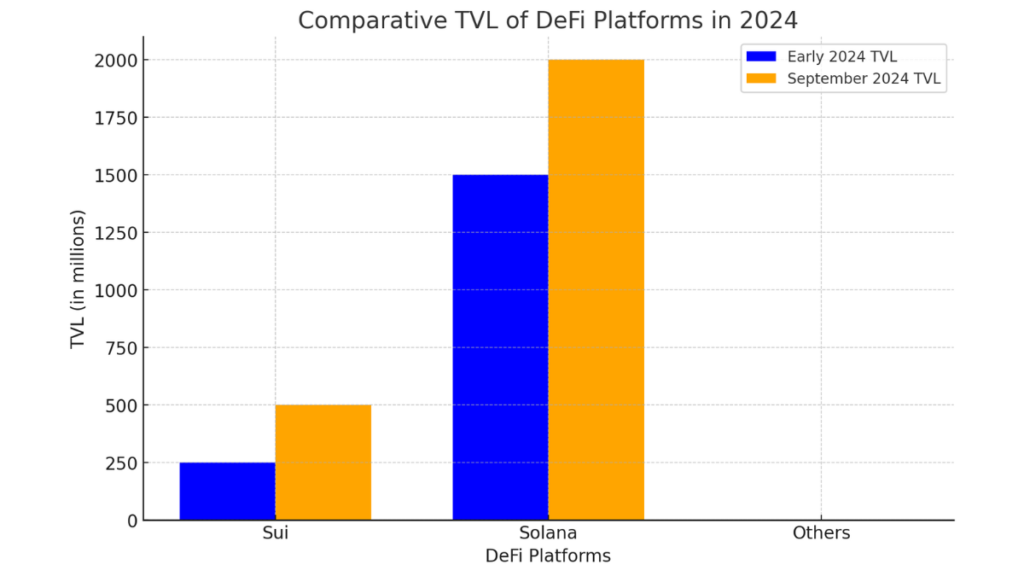
The bar chart above provides a comparative overview of the Total Value Locked (TVL) in major DeFi platforms in 2024. It shows the TVL in millions for “Sui,” “Solana,” and “Others” both in early 2024 and September 2024. This visual representation highlights the significant growth in TVL for platforms like Sui and Solana, in contrast to the overall decline observed in the broader DeFi market.
Historical Context of DeFi TVL Decline
The current decline in DeFi TVL echoes previous downturns in the DeFi market’s short history. Similar to past cycles, the TVL fluctuations in 2024 appear to be driven by market volatility, investor sentiment, and external pressures such as regulatory actions. However, the unique aspect of this decline is the simultaneous growth seen in specific platforms, highlighting the market’s evolving dynamics. Comparing this decline to previous ones, it becomes evident that the DeFi market is maturing, with platforms either adapting to market conditions or falling behind.
Market Impact of DeFi TVL Decline
The decline in Total Value Locked (TVL) in DeFi has brought significant changes to the broader market dynamics, affecting liquidity, trading volumes, and investor sentiment. In the short term, the drop in TVL has led to reduced liquidity, making it more challenging for traders to execute large transactions without experiencing slippage. In the long term, the decline could signal waning confidence in DeFi, affecting the growth and adoption of decentralized finance services.
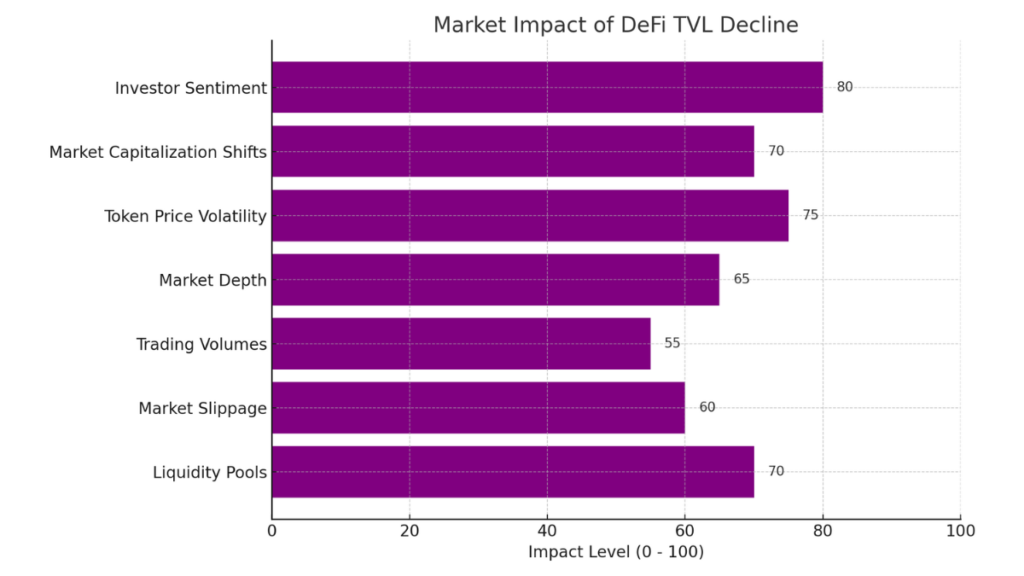
The horizontal bar chart above visualizes the market impact of the DeFi TVL decline across various categories. Each category, such as “Liquidity Pools,” “Market Slippage,” “Trading Volumes,” and “Investor Sentiment,” is given an impact score on a scale from 0 to 100, indicating the level of effect the TVL decline has had on each aspect of the DeFi market. This representation helps in quickly assessing which areas are most affected by the reduction in TVL, with categories like “Investor Sentiment” and “Token Price Volatility” showing higher impact scores.
Effects on DeFi Liquidity and Market Efficiency
The reduction in TVL has directly impacted liquidity pools on various DeFi platforms. Liquidity pools rely on user deposits to maintain a reserve of tokens for trading, lending, and other DeFi activities. When TVL declines, there are fewer assets available in these pools, which can lead to several issues:
- Impact on Liquidity Pools: A lower TVL means less crypto is locked in liquidity pools, which decreases the available assets for trading. This can lead to less efficient markets where larger trades result in significant price slippage.
- Market Slippage: Reduced liquidity increases the risk of slippage, where the price of an asset changes between the initiation and execution of a trade. This is particularly problematic in volatile markets, where prices can shift rapidly.
- Reduced Trading Volumes: With lower liquidity, traders may find it harder to execute large orders without affecting market prices, leading to decreased trading volumes and market depth.
- Decreased Market Depth: A decline in TVL also means that the market lacks the “depth” to support high-volume trades, making DeFi less attractive for institutional investors and large-scale traders.
These factors together highlight how a decline in TVL can reduce market efficiency, leading to more volatile and less predictable trading conditions.
Influence on DeFi Token Prices
The decrease in TVL has had a ripple effect on DeFi token prices. TVL is often used as a measure of a platform’s health and success; hence, a decline in TVL can lead to:
- Price Volatility: A shrinking TVL can signal to investors that a DeFi platform is losing its competitiveness or facing issues, which can trigger a sell-off of its native tokens. This sell-off increases price volatility.
- Market Capitalization Shifts: As TVL decreases, the market capitalization of many DeFi tokens may also decline, reflecting reduced investor confidence in the platform’s ability to sustain its growth.
- Impact on DeFi Yields: Lower TVL can result in reduced yields for liquidity providers. As yields diminish, fewer investors may be incentivized to lock their assets in liquidity pools, exacerbating the TVL decline.
Overall, the reduction in TVL can create a negative feedback loop, where decreasing token prices and yields further reduce investor participation, leading to additional market volatility.
Impact on Investor Sentiment and Market Volatility
The decline in DeFi TVL has notably affected investor sentiment, leading to increased market volatility:
- Investor Sentiment: TVL is seen as a key health indicator of DeFi protocols. When it declines, it can cause concern among investors about the stability and future growth prospects of the DeFi sector. This can result in a shift toward more conservative investment strategies or a move to other sectors within the crypto market.
- Market Effects on DeFi Protocols: Lower TVL can lead to concerns about the sustainability of DeFi protocols, particularly those that rely heavily on user participation for liquidity. This uncertainty can cause sudden shifts in market behavior, such as rapid sell-offs or decreased lending and borrowing activity.
- Market Volatility: The overall crypto market can become more volatile due to the interconnectedness of DeFi platforms. A significant decline in TVL across multiple DeFi platforms can lead to increased market-wide uncertainty, affecting other cryptocurrencies and leading to heightened market swings.
Note
The ongoing fluctuation in TVL underscores the importance of monitoring DeFi trends and investor sentiment, as these elements are closely linked to the overall stability and growth of the DeFi market.
Role of On-Chain Derivatives and Layer-2 Solutions in DeFi TVL
Amid the decline in Total Value Locked (TVL) across DeFi platforms, on-chain derivatives and layer-2 solutions have emerged as vital components for sustaining market interest and providing alternative growth avenues. These technologies have helped mitigate the effects of TVL decline by enhancing trading efficiency, reducing costs, and maintaining liquidity within the ecosystem.
Growth of On-Chain Derivatives Amid TVL Decline
The adoption of on-chain derivatives has played a crucial role in maintaining activity within DeFi markets despite the TVL decline. On-chain derivatives allow traders to engage in complex financial transactions directly on the blockchain, such as futures, options, and swaps, which are vital for hedging risks and speculating on price movements. These instruments have attracted significant market interest by offering more sophisticated trading strategies, thereby helping to sustain DeFi market adjustments even when TVL is under pressure. By enabling leveraged trading, derivatives help generate trading volume and market liquidity, which can partially offset the effects of declining TVL. As traders use these products to manage their risk exposure, they contribute to a more dynamic and resilient DeFi market.
Layer-2 Solutions and Their Influence on DeFi TVL
Layer-2 solutions have been instrumental in enhancing DeFi’s resilience by addressing key limitations like high transaction fees and scalability issues on the primary blockchain networks. For instance, layer-2 networks such as Optimism and Arbitrum offer faster and more cost-effective transactions, which encourage users to continue engaging with DeFi platforms even amid the decline in TVL. By enabling quicker and cheaper transactions, layer-2 solutions have attracted more users to participate in DeFi activities, ensuring sustained market efficiency. This has led to new developments such as Visa’s layer-2 network aimed at facilitating stablecoin and central bank digital currency exchanges, indicating how layer-2 adoption can help mitigate some impacts of TVL decline. Additionally, platforms like DeBank have launched on Optimism’s OP Stack to lower transaction costs and boost accessibility, contributing positively to the TVL trends in decentralized finance.
Effects of Derivatives on DeFi Liquidity
Derivatives trading has had a significant impact on maintaining liquidity in DeFi markets. By providing instruments that allow traders to hedge risks and speculate on market movements, derivatives contribute to an active and liquid market environment. For instance, platforms offering derivative products can attract more traders, thereby increasing the liquidity pool and mitigating the effects of TVL decline. This active trading in derivatives ensures that even when TVL decreases, the market remains liquid enough to support various financial activities.
Here is a summary table of some notable derivatives platforms and their impact on liquidity:
| Derivatives Platform | Impact on Liquidity | TVL Figures (Approx.) |
|---|---|---|
| Uniswap | High | $5 Billion |
| Synthetix | Moderate | $2 Billion |
| dYdX | High | $1.5 Billion |
| Perpetual Protocol | Moderate | $1 Billion |
The presence of these platforms showcases how derivatives trading can support DeFi liquidity, helping maintain market functionality and providing traders with the tools necessary to operate in a volatile market.

The bar chart above displays the TVL (Total Value Locked) figures for notable DeFi derivatives platforms, showing the impact of on-chain derivatives on maintaining liquidity in the DeFi market. Each platform, including Uniswap, Synthetix, dYdX, and Perpetual Protocol, is represented with its approximate TVL in billions of dollars. This chart highlights the varying levels of liquidity across these platforms, illustrating how derivatives contribute to the overall DeFi ecosystem.
Note
- Current Bitcoin Price Trends
- Crypto Market Reactions to Interest Rate Changes
- Decentralized Exchanges Growth Amid Meme Coins
- Stablecoin Price Volatility in September 2024
Future Outlook and Potential Recovery of DeFi TVL
Despite the recent decline in Total Value Locked (TVL) in the DeFi sector, the future holds several promising avenues for recovery and growth. Market adaptability and technological advancements suggest a potential rebound as platforms continue to innovate and address existing challenges.
Factors That Could Drive TVL Recovery

The radar chart above illustrates the key factors influencing the potential recovery of DeFi TVL in 2024. Each category, such as “Improved User Interfaces,” “Regulatory Clarity,” and “New Protocols Impact,” is scored on its potential impact on TVL recovery on a scale of 0 to 100. This visual representation shows the relative influence of each factor on the future outlook of DeFi TVL, highlighting areas like “New Protocols Impact” and “Institutional Participation” as having the highest potential impact.
Several key factors could contribute to a potential recovery in DeFi TVL:
- Improved User Interfaces: Enhancing user experience through intuitive interfaces and streamlined processes can attract a broader audience, including less tech-savvy individuals, to DeFi platforms.
- Regulatory Clarity: Clearer regulations can boost investor confidence by reducing uncertainties. This can pave the way for increased participation from both retail and institutional investors, positively influencing TVL.
- Increased Institutional Participation: As institutions grow more comfortable with the DeFi landscape, their involvement can significantly boost TVL. Institutional investments bring in substantial capital, leading to more stable liquidity and market growth. For instance, recent reports indicate growing institutional interest in DeFi, which could drive TVL recovery in the coming months.
Additionally, the rapid growth of ecosystems like Sui and Avalanche suggests that strategic developments and innovations can drive a surge in TVL, indicating a potential upward trajectory for DeFi platforms in 2024.
Expected Impact of New DeFi Protocols on TVL
The introduction of new DeFi protocols and platforms is expected to influence TVL growth. For example:
- Sui’s Impressive Growth: Sui, a fast-growing Layer 1 blockchain, has recently demonstrated astounding growth by surpassing the $500 million TVL mark in early 2024. This growth is attributed to Sui’s object-centric model, horizontal scalability, and innovative programming language, positioning it as a scalable solution in the blockchain industry.
- Avalanche’s Surge: Avalanche’s ecosystem has also shown significant growth, with its TVL nearly doubling in just two months, reaching approximately $911 million. This surge is driven by increasing user activity and development within its ecosystem, indicating the potential impact new protocols can have on TVL.
Note
The examples showcase how the launch and expansion of new protocols can attract users and capital, driving an overall increase in TVL across the DeFi sector.
Market Sentiment and TVL Projections for Late 2024
Market sentiment toward DeFi TVL remains cautiously optimistic. Key projections for late 2024 include:
- Potential TVL Growth: Optimism around the DeFi market remains high, with some industry experts projecting that the market could swell to $1 trillion in the coming year. Such projections are based on the growing interest in decentralized finance and the development of new, innovative DeFi products.
- Investor Behavior: Current trends indicate that investor sentiment is gradually shifting towards a more positive outlook. Increasing inflows into DeFi projects, especially those with strong fundamentals and utility, suggest that investors are actively seeking opportunities in the space despite recent TVL fluctuations.
Key Observations:
While the DeFi sector has faced challenges in recent months, the introduction of innovative protocols, the promise of regulatory clarity, and growing institutional interest present a hopeful outlook for TVL recovery and growth in 2024.
The decline in DeFi TVL in 2024 has had a profound impact on market dynamics, liquidity, and investor sentiment. However, the market’s resilience is evident as it adapts to these challenges through the growth of on-chain derivatives, layer-2 solutions, and the emergence of new protocols. Factors such as improved user interfaces, regulatory clarity, and increased institutional participation offer promising pathways for TVL recovery. The rise of platforms like Sui and Avalanche underscores the DeFi market’s ability to innovate and attract new capital. As the sector continues to evolve, projections for a potential TVL rebound remain optimistic, with some experts foreseeing a significant surge in the coming year.



